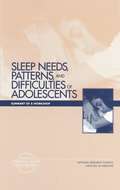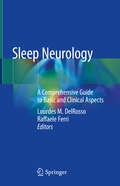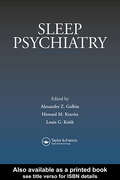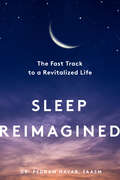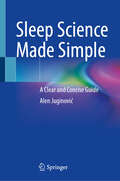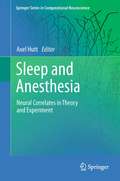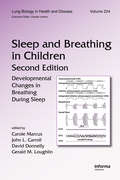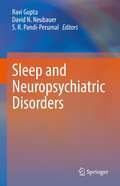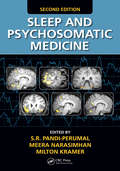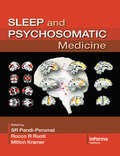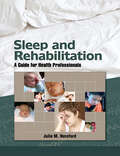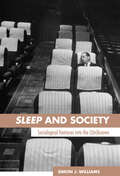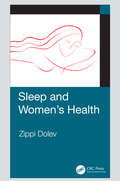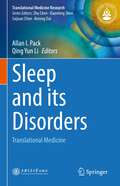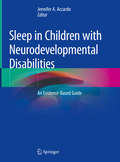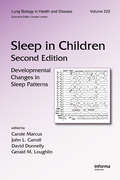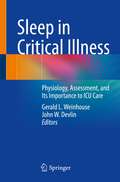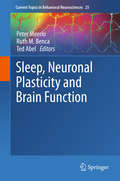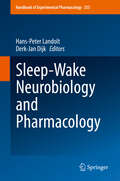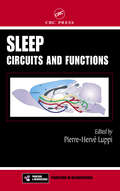- Table View
- List View
Sleep Needs, Patterns, And Difficulties Of Adolescents: Summary Of A Workshop
by Forum On AdolescenceA summary on Sleep Needs, Patterns, And Difficulties Of Adolescents
Sleep Neurology: A Comprehensive Guide to Basic and Clinical Aspects
by Lourdes M. DelRosso Raffaele FerriThis practical text provides knowledge of the basic neuroscience of sleep and sleep disorders as they interrelate with various neurologic conditions.Chapters in the first section cover neural networks involved in normal sleep processes, including dreams and memory. Also discussed are how these neural networks interact in various sleep stages and sleep disorders, such as sleep related movement disorders. The book's second section explores the pathophysiology of sleep disorders in the spectrum of neurologic conditions in both adults and children. This includes sleep changes in patients with dementia, seizures, headaches, and stroke, and other common neurologic disorders. Sleep Neurology fills an important gap in the sleep medicine literature by providing the underpinnings of sleep disorders and will be of great value to students, residents, and clinicians.
Sleep Psychiatry
by Louis G. Keith Alexander Z. Golbin Howard M. KravitzSleep medicine is a growing field. As is often the case in any rapidly expanding field, the literature has become abundant and often controversial. At the same time, specialized textbooks, manuals, periodicals, and papers are not easily accessible and are difficult to interpret for the practical needs of general practitioners, psychiatrists, and ot
Sleep Reimagined: The Fast Track To A Revitalized Life
by Pedram NavabDitch insomnia in as little as 4 weeks with this 6-step therapeutic program for better sleep. Insomnia looks different for everyone. Whether it’s caused by stress, a traumatic life event, or even a snoring partner, poor sleep can affect the quality of your waking life. But Dr. Pedram Navab wants readers to know that it’s not a lost cause—falling asleep can be just as easy as waking up. With his cognitive behavioral therapy (CBT-I) program, paired with relatable case studies of different sleep disorders, readers are guided to new and improved sleep in as little as 4 weeks. In Sleep Reimagined, the 6-step CBT-I program teaches readers how to understand sleep, rewire their arousal system through therapeutic relaxation, practice sleep restriction and stimulus control, restructure attitudes towards sleep, use mindfulness intervention to continue cognitive components, and prevent insomnia relapse through planning. Both comprehensive and entertaining, this book is the perfect bedside companion to discover better sleep and better life.
Sleep Science Made Simple: A Clear and Concise Guide
by Alen JuginovićThis book brings the fascinating world of sleep biology to life in clear, accessible language. Dr. Juginovic reveals what happens during the third of our lives we spend asleep—and why it matters so profoundly for our mental and physical health. Drawing on the latest research, the book demystifies how sleep works, explaining its powerful effects on everything from memory and metabolism to heart health, immunity, mental wellbeing, and even cancer risk. With vivid explanations and relatable examples, it explores the neurobiology of sleep and how this vital process supports nearly every system in the body. Whether you're new to the science of sleep, a healthcare professional, an athlete, or a business leader striving for high performance, this book offers something for everyone. Chapters break down complex concepts into clear, relatable language while preserving scientific depth and accuracy. Sleep Science Made Simple is more than just informative—it&’s a call to action. It invites readers to rethink their sleep habits, understand their importance, and make lasting changes to improve overall health, performance, and quality of life.
Sleep and Anesthesia
by Axel HuttSleep and anesthesia resemble in many ways at a first glance. The most prominent common feature of course is the loss of consciousness, i.e. the loss of awareness of external stimuli. However a closer look at the loss of consciousness reveals already a difference between sleep and anesthesia: anesthesia is induced by an anesthetic drug whereas we may fall asleep without external cause. Other questions may arise about the difference of the two effects: do we dream during surgery under anesthesia, do we feel pain during sleep? Essentially, we may ask: what is common and what are the differences between sleep and anesthesia? To answer these questions, we may take a look at the neural origin of both effects and the involved physiological pathways. In which way do they resemble? Moreover, we ask what are the detailed features of normal sleep and general anesthesia as applied during surgery and which features exist in both phenomena? If yes in which way? To receive answers to these questions, it is necessary to consider several experimental techniques that reveal underlying neural mechanisms of sleep and anesthesia. Moreover, theoretical models of neural activity may model both phenomena and comes up with predictions or even theories on the underlying mechanisms. Such models may attack several different description levels, from the microscopic level of single neurons to the macroscopic level of neural populations. Such models may give deeper insight into the phenomena if their assumptions are based on experimental findings and their predictions can be compared to experimental results. This comparison step is essential for valuable theoretical models. The book is motivated by two successful workshops on anesthesia and sleep organized during the Computational Neuroscience Conferences in Toronto in 2007 and in Berlin 2009. It aims to cover all the previous aspects with a focus on the link to experimental findings. It elucidates important issues in theoretical models that at the same time reflect some current major research interests. Moreover it considers some diverse issues which are very important to get an overview of the fields. For instance, the book discusses not only neural activity in the brain but also the effects of general anesthesia on the cardio-vascular system and the spinal cord in the context of analgesia. In addition, it considers different experimental techniques on various spatial scales, such as fMRI and EEG-experiments on the macroscopic scale and single neuron and LFP-measurements on the microscopic scale. In total all book chapters reveal aspects of the neural correlates of sleep and anesthesia motivated by experimental data. This focus on the neural mechanism in the light of experimental data is the common feature of the topics and the chapters. In addition, the book aims to clarify the shared physiological mechanisms of both phenomena, but also reveal their physiological differences.
Sleep and Breathing in Children: Developmental Changes in Breathing During Sleep, Second Edition (Lung Biology in Health and Disease)
by John L. Carroll Gerald M. Loughlin Carole L. Marcus David F. DonnellyInfants and children spend one- to two-thirds of their life asleep. Despite this, very little attention has been paid to understanding both normal sleep and sleep-related abnormalities during child development. This volume is devoted to breathing during sleep, its changes with development (from the fetus onwards), and the pathophysiology of sleep-r
Sleep and Clocks in Aging and Longevity (Healthy Ageing and Longevity #18)
by Anita JagotaThis edited volume focuses on the interplay between sleep and circadian rhythms with health, aging and longevity. Sleep is absolutely important for human health and survival, as insufficient sleep is associated with a plethora of conditions, including the poor quality of life, onset of several diseases, and premature death. The sleep–wake cycle is an evolutionary conserved neurobiological phenomenon, and is a prominent manifestation of the biological clocks localised in the suprachiasmatic nucleus (SCN). Understanding bidirectional relationship between sleep and circadian rhythms is of utmost importance and urgency, especially in the context of modern lifestyle where sleep is often out of phase with the internal body clocks, social jetlag, artificial lights and so on. The 25 chapters by leading researchers and experts from 11 countries are arranged into seven sections: understanding sleep and clock interlink in health and longevity; sleep, aging and longevity; clock, aging and longevity; melatonin, sleep and clock; genetic regulation of sleep and clock; therapeutic interventions in sleep disorders and clock misalignment; and experimental models to study sleep and clocks in aging and longevity. This book is useful for advanced undergraduate and graduate students, and researchers, educators, and other biomedical professionals.
Sleep and Neuropsychiatric Disorders
by S. R. Pandi-Perumal Ravi Gupta David N. NeubauerThis book explores the intricate links between sleep and neuropsychiatric diseases. In clinical settings, understanding the development, treatment, and management of neuropsychiatric diseases poses a substantial challenge. Neuropsychiatric disorders place a significant cost on society, affecting the health of people affected, care providers, and the general community. Sleep and neuropsychiatric disease are inextricably linked. Sleep disorders are widespread in these populations and are frequently overlooked in neurology and psychiatry.The book offers readers up-to-date information on different facets of the bidirectional connections between sleep and neuropsychiatric diseases. Following the initial fundamental science part, a unique series of chapters concentrate on the behavioural manifestations of sleep problems, a hitherto unexplored field. Additional chapters include patient evaluation techniques as well as public health implications of sleep disorders. The individual chapters cover all main mental and neurological diseases where a change in sleep is evident, and recent concepts in pathogenesis, presentation, evaluation, and treatment. Neuropsychotropic drugs must be seen as a double-edged sword when it comes to sleep and sleep disorders. Overall, this book is an excellent resource for learning about neuropsychiatric diseases and how they affect sleep while simultaneously being impacted by sleep.
Sleep and Perinatal Psychiatric Disorders: A Comprehensive Guide for Clinicians and Researchers
by Verinder Sharma Laura PalaginiThis book provides an up-to-date overview of sleep disturbance in perinatal psychiatric disorders. There is accumulating scientific evidence that psychiatric illnesses, such as anxiety disorders, obsessive-compulsive disorder, and post-traumatic stress disorder, can begin or recur during the peripartum period. However, the general lack of awareness of their common occurrence, coupled with an exclusive focus on screening for perinatal depression, may lead to their underdiagnosis or misdiagnosis. This book intends to create an awareness of the ubiquity of sleep loss and insomnia in the peripartum period and its potential role in the onset and exacerbation of various psychiatric disorders. Divided into five sections, the book&’s first section is a discussion of adverse pregnancy, delivery, and fetal outcomes of prenatal psychiatric disorders. Section II describes the effect of common peripartum psychiatric disorders—including mood and anxiety disorders, obsessive-compulsive disorder, and post-traumatic stress disorder—on sleep and vice versa. The three chapters of Section III deal with the screening, evaluation, diagnosis, and prevention of peripartum psychiatric disorders. Section IV focuses on the pharmacological and psychotherapeutic treatment of peripartum insomnia and the effect of breastfeeding on maternal sleep. The concluding section discusses the importance of targeting sleep loss and insomnia in the treatment of various psychiatric disorders during and after pregnancy. Sleep and Perinatal Psychiatric Disorders: A Comprehensive Guide for Clinicians and Researchers will be a valuable resource for clinicians of various backgrounds including psychiatrists, psychologists, primary care providers, internal medicine physicians, sleep medicine specialists, and obstetricians. Due to its focus on recent advances in research and new directions in the field, the book will also appeal to researchers.
Sleep and Psychiatric Disorders in Children and Adolescents (Sleep Disorders)
by Anna IvanenkoThe first book to offer an in-depth study of the relationship between sleep disorders and common psychiatric disorders in children, this new addition to Informa‘s Sleep Disorders series covers: sleep and attention deficit/hyperactivity disorder, autism, anxiety, and depressionsleep disorders and obesity (including diabetes and metabolic syndrome),
Sleep and Psychosomatic Medicine
by S.R. Pandi-Perumal Meera Narasimhan Milton KramerSleep and Psychosomatic Medicine presents an overview of sleep medicine and the management of common sleep disorders seen in a wide variety of practice settings. Chapters have been written by experts in the field in order to provide physicians of a wide range of interests and abilities with a highly readable exposition of the principal results, including numerous well articulated examples and a rich discussion of applications. The second edition has been revised to further broaden the scope with the inclusion of several new chapters such as Sleep and Dermatology, Fatigue in Chronic Medical Conditions, Occupational Sleep Medicine, Restless Legs Syndrome and Neuropsychiatric Disorders and Sleep Dysfunction after Traumatic Brain Injury, to name a few. This second edition of Sleep and Psychosomatic Medicine is an interdisciplinary, scholarly, authoritative, evidence-based review of the field designed to meet the needs of a wide range of health care professionals, including psychiatrists, psychologists, nurses, medical students, and social workers in health care settings.
Sleep and Psychosomatic Medicine
by Milton Kramer Rocco R Ruoti Sr Pandi-PerumalPsychosomatic illness can generally be considered as physical illnesses that are believed to be psychologically based; hence they are often referred to as "psychophysiological" disorders. Focusing on the emerging challenges in the fields of both sleep and psychosomatic medicine, Sleep and Psychosomatic Medicine interphases between psychiatry, sleep
Sleep and Rehabilitation: A Guide for Health Professionals
by Julie HerefordSleep and Rehabilitation: A Guide for Health Professionalsis a concise reference for the health professional looking to further understand sleep and how sleep science may impact particular areas of various rehabilitation disciplines. Dr. Julie M. Hereford and her contributors present Sleep and Rehabilitation: A Guide for Health Professionalsin an easy-to-read manner by dividing the text into four main sections. The first section provides a review of the basic scientific understanding of sleep. While there are many other publications that present a basic scientific understanding of sleep, Sleep and Rehabilitation systematically gears this information toward the rehabilitation professional with commonly used terminology, descriptions of sleep architecture, and information concerning sleep hygiene. The middle sections of Sleep and Rehabilitationdescribe disordered sleep and how it pertains to patients seen in the rehabilitation setting. It guides the health professional to recognize the manifestations and consequences of disordered sleep and teaches the rehabilitation professional how to interpret a sleep study in order to provide guidance in clinical decision making. Finally, the last section of Sleep and Rehabilitationprovides the ever-important practical application of the theoretical principles in sleep rehabilitation.Features include: Discussion on the science of polysomnography Sleep and sleep dysfunction from a rehabilitation perspective Sleep dysfunction as it relates to the clinical needs of a patient undergoing the rehabilitation process Discussion on the particular concerns that sleep and sleep dysfunction can hold for rehabilitation patients and issues to be addressed by the provider Presentation of unique issues that disordered sleep may present in the rehabilitation process such as on pain, pain management, motor learning, and memory and performance enhancement Tools to assess quality and quantity of a patient’s sleep Discussion on methods in which sleep may be manipulated in order to optimize a patient’s physical performance Sleep and Rehabilitation: A Guide for Health Professionalsis a one-of-a-kind reference that will help the health professional incorporate the science of sleep into the rehabilitation process.
Sleep and Society: Sociological Ventures into the Un(known)
by Simon J. WilliamsExploring the sociological aspects of sleep and their links to current health debates, this unique text discusses why sleep has been so neglected in sociological literature and examines significant modern issues such as: the 24-hour society sleep and work homelessness dream analysis the medicalization and commodification of sleep. Written by a key international figure in medical sociology, this is the first sociological examination of sleep, making it important reading for academics and advanced students of medical sociology, health studies, and sociology, as well as for professionals and policy makers involved in the area.
Sleep and Women's Health
by Zippi DolevWhy is it that women suffer far more than men from insomnia? What is the connection between the hormonal changes that a woman undergoes during her lifetime, and difficulty in falling asleep? What is the effect of cell phones on sleep? Should women engage in sports before going to sleep? What do women primarily dream about? In which country do people sleep the most? How do depression and anxiety affect sleep? And why is it inadvisable to resort to a "little pill" to provide unworried sleep? This clear and readable book, illustrated with short quotations of poetry and prose about sleep and dreams, provides a glimpse into the wonderful mechanism of sleep, explains how correct treatment of sleep disturbances results from understanding their causes, and shows the right path to a pleasant and satisfying night’s sleep; it will be of great interest for all women and clinicians dealing with female patients. In particular, because of the connection between sleep and hormones, problems with sleep have repercussions for women’s reproductive life cycle. This pioneering text will therefore be of particular interest to gynecologists working in Reproductive Medicine.
Sleep and its Disorders: Translational Medicine
by Allan I. Pack Qing Yun LiThe aim of this book is to provide health care professionals with an overview of the main aspects of recent advances in sleep medicine, with an emphasis on advancing basic science into clinical medicine. It is divided into three main parts. The first part is to cover the basic sleep mechanisms which includes genetics in sleep, and neural and humoral regulation of sleep and wakefulness. The second part focuses on the epidemiology of sleep, and the final part consists of the pathophysiological mechanisms of snoring and sleep apnea and other common sleep disorders as well as the consequences. The content of this book is written by experts and sleep specialists from all over the world and this book aims to optimize the health of individuals by “translating” bench side findings into clinical practice.
Sleep in Children with Neurodevelopmental Disabilities: An Evidence-Based Guide
by Jennifer A. AccardoThis practical guide presents approaches to working with children and adolescents with neurodevelopmental disabilities who have sleep problems. Divided into four sections, the book begins with the impact of sleep problems in children with disabilities and the evaluation of sleep complaints. The next two sections cover the major categories of sleep disorders as they apply in children with disabilities, and specific neurodevelopmental disabilities with their characteristic sleep manifestations. The last section details options for treatment, which include behavioral and environmental strategies, occupational therapy, exercise, and medications. Chapters feature case studies that introduce and reinforce diagnostic and therapeutic approaches. Those engaged in the care of children with neurodevelopmental disabilities and sleep problems will find this text to be an invaluable guide when assessing and treating sleep disorders.
Sleep in Children: Developmental Changes in Sleep Patterns, Second Edition (Lung Biology in Health and Disease)
by John L. Carroll Gerald M. Loughlin Carole L. Marcus David F. DonnellyInfants and children spend one- to two-thirds of their life asleep. Despite this, very little attention has been paid to understanding both normal sleep and sleep-related abnormalities during child development. There are profound changes in sleep and circadian rhythm during growth and maturation. Sleep is particularly important in children, due to
Sleep in Critical Illness: Physiology, Assessment, and Its Importance to ICU Care
by Gerald L. Weinhouse John W. DevlinFor decades heavily sedated ICU patients were assumed to be asleep. However, in the past 20 years, physiologic and epidemiologic studies have established sleep is frequently disrupted in the ICU. The inter-relationship between ICU sleep, delirium, and survivorship has come to the forefront of ICU practice. We now routinely aim for lighter sedation, delirium assessment has become standardized, and knowledge regarding the ICU factors leading to Post- Intensive Care Syndrome (PICS) has evolved. The importance of sleep in routine ICU management was codified for the first time in SCCM’s 2018 PADIS guidelines. This state of the art book summarizes current knowledge regarding sleep during critical illness and recovery and how the risk factors, recognition, and outcomes associated with sleep in the ICU differ from those of healthy adults. Chapters address sleep quality in both the research environment and during routine care, the factors that disrupt sleep architecture and circadian biology in the ICU setting, medications that alter sleep architecture and those that can be used to improve it, the relationship between sleep and sedation and between sleep and delirium, and current strategies that can be used to improve sleep in the vulnerable ICU population. Written by experts in the field, Sleep in Critical Illness is a valuable resource for all members of the ICU interprofessional team including critical care physicians, nurses, physician assistants, pharmacists, and respiratory therapists as well as clinicians who consult in the ICU and post-ICU settings.
Sleep, Neuronal Plasticity and Brain Function
by Peter Meerlo Ruth M. Benca Ted AbelThis book reviews current knowledge on the importance of sleep for brain function, from molecular mechanisms to behavioral output, with special emphasis on the question of how sleep and sleep loss ultimately affect cognition and mood. It provides an extensive overview of the latest insights in the role of sleep in regulating gene expression, synaptic plasticity and neurogenesis and how that in turn is linked to learning and memory processes. In addition, readers will learn about the potential clinical implications of insufficient sleep and discover how chronically restricted or disrupted sleep may contribute to age-related cognitive decline and the development of psychiatric disorders such as schizophrenia and depression. The book consists of 19 chapters, written by experts in basic sleep research and sleep medicine, which together cover a wide range of topics on the importance of sleep and consequences of sleep disruption. This book will be of interest to students, researchers and clinicians with a general interest in brain function or a specific interest in sleep.
Sleep, Personality, and Social Behavior
by Zlatan KrižanThe purpose of this book is to survey the limited scientific knowledge about how sleep intersects with personality and social behavior. This edited volume establishes a new interdisciplinary field of inquiry about sleep that examines sleep processes in the context of social behavior and social-cognitive processes (e.g., liking, respecting, helping, hurting, achieving), as well as individual differences in personality (i.e., chronic patterns of emotion, thought, and behavior). Contributors identify key gaps in scientific knowledge about sleep and its import for personality-social processes, aiming to shape future research efforts by scholars in psychology, biology, sociology, and sleep medicine.Among the topics discussed:How sleep shapes emotion regulationSleep and temperament in early childhoodDynamics between sleep and self-controlImplications for task performanceInfluence of sleep on social cognition and judgmentSleep, Personality, and Social Behavior comprehensively examines the role of sleep in emotion and motivation, the impact of sleep on social-cognitive processes, the dynamics between sleeping and relationships functioning, the import of sleep for group behavior, the role of personality differences in sleep, and the role of sleep in personality and social development. Researchers in personality and social psychology, health psychology, and neurology will find this an insightful book that addresses the significant gaps in scientific understanding of sleep.
Sleep, Stroke, and Cardiovascular Disease
by Antonio CulebrasThe relationship between sleep disorders - in particular sleep apnea, a highly prevalent condition - and common vascular disturbances such as stroke and hypertension is an area of active research. Summarizing the clinical evidence to date between sleep disorders and vascular pathology, this is the first time a comprehensive overview of this relationship has been covered in a single volume. Bringing together some of the world's most renowned authors in the field, Sleep, Stroke and Cardiovascular Disease contains recommended treatment plans - allowing for rapid and accurate diagnosis and management of patients - enabling learning from real experience. Of interest, not only, to specialists who intervene in diagnosis and management of sleep and stroke disorders such as neurologists, cardiologists and pulmonologists, the book will also be of value to primary-care practitioners, allowing them to arrive at better diagnoses and management of sleep and vascular disorders.
Sleep-Wake Neurobiology and Pharmacology (Handbook of Experimental Pharmacology #253)
by Hans-Peter Landolt Derk-Jan DijkThis volume connects current ideas and concepts about sleep functions and circadian rhythms with the search for novel target-selective sleep-wake therapeutics. To do so, it provides a timely, state-of-the-art overview of sleep-wake mechanisms in health and disease, ongoing developments in drug discovery, and their prospects for the clinical treatment of sleep-disordered patients. It particularly focuses on the concept that sleep and wakefulness mutually affect each other, and the future therapeutic interventions with either sleep- or wake-promoting agents that are expected to not only improve the quality of sleep but also the waking behavior, cognition, mood and other sleep-associated physiological functions.The chapter 'Sleep Physiology, Circadian Rhythms, Waking Performance and the Development of Sleep-Wake Therapeutics' available open access under a CC BY 4.0 license at link.springer.com
Sleep: Circuits and Functions
by Pierre-Hervé LuppiAn estimated 40 million Americans and millions of others worldwide suffer from some type of sleep disruption or disorder, and these numbers are rapidly increasing. As biomedical technologies advance our understanding of sleep, a wave of developments in sleep research and the emergence of new technologies offer hope and help for a good night‘s
